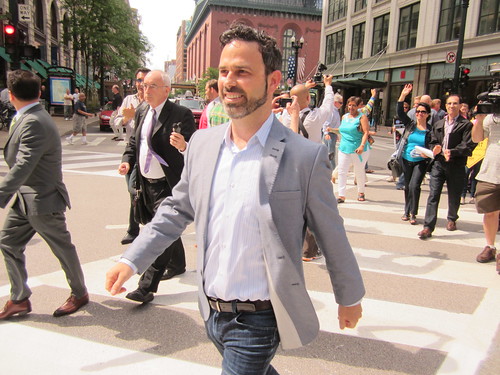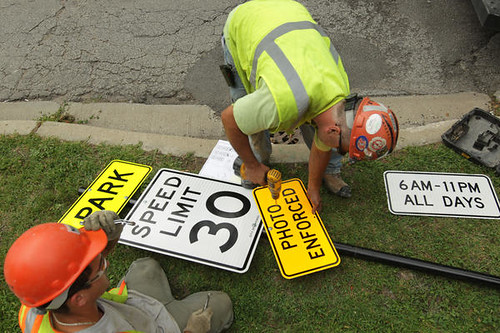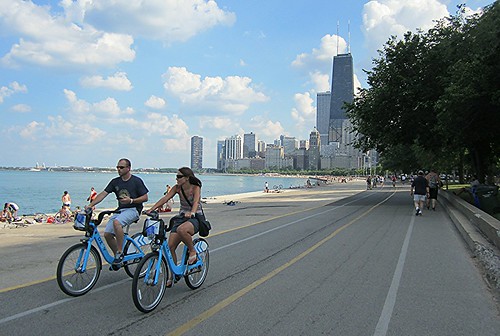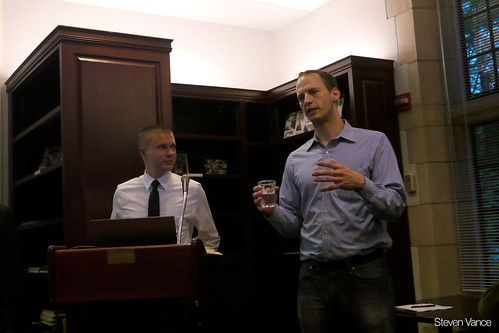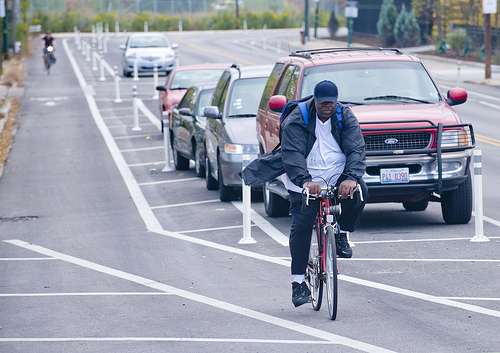[A shorter version of this article ran in Checkerboard City, John’s column in Newcity magazine, which hits the streets on Wednesday evenings.]
Maybe I jinxed things by naming transportation czar Gabe Klein as the city’s best department head in Newcity’s October 31 Best of Chicago issue, because the very next day he announced he was stepping down. Can’t really blame the guy since, two-and-a-half years after he took the job, his wife is still living in his previous hometown of Washington, D.C., where he’ll be returning to launch new transportation technology enterprises in the private sector. Still, it’s a shame that the poster boy for reconfiguring urban streets to serve all road users, not just drivers, is leaving the Windy City in his bicycle taillights. I caught up with Klein at his downtown office for a final chat.
John Greenfield: To ask the classic annoying job interview question, what was your biggest weakness as commissioner?
Gabe Klein: Coming to town and not necessarily understanding all the history of how the city works meant there was a bigger learning curve. I came in with Mayor Emanuel and had this idea that we were going to set the world on fire and change transportation in Chicago. That’s a double-edged sword. If I didn’t think that way, we wouldn’t have been able to get as much done, but you also rub some people the wrong way. So maybe I could have been a little less boisterous? I don’t know.
JG: Were there any projects that you were disappointed you weren’t able to accomplish or finish?
GK: As a human you’re always going to wish you could have done more, and tied up that one loose end. Like I wish bus rapid transit was already launched instead of kicking off in January [with a route between Union Station to Navy Pier.] When I sat down with the mayor after he hired me, I laid out about a hundred things I wanted to do. He said, “This is great, but shouldn’t we focus on two or three things?” I said, “If we focus on two or three things, in couple of years we’ll have accomplished one or two of those things. But if we shoot for a hundred things and knock out 70, 75 of those things, you’re going to be really happy with how much we accomplished.”
The thing you see in [transportation departments] sometimes is this very slow, incremental approach, where you don’t upset too many people, you don’t push your staff too hard, and you don’t upset the public through too much change at once. The problem is, not much happens. This mayor, my previous boss [former D.C. mayor Adrian Fenty], and me, we embody the urgency of making change: the economic urgency, the safety urgency. I was looking at Chicago’s pedestrian fatality numbers this year and they’re down over 45 percent this year over last year. [2012 was an unusually deadly year for peds with 48 fatalities.] We didn’t have any last month. People ask why we’re doing so many things so fast. It’s because people’s lives depend on it.
And it’s not always about the mega projects. We found funding to do the riverwalk extension. We put together federal money for the Bloomingdale Trail that was completely unfunded when the mayor came in. But it’s the little things that have had the biggest impact. The Divvy program has cost the city about $5.5 million in matching funds [federal funding covered the remaining $22 million]. That’s the cost of maybe one-and-a-half CTA rail cars, and look at the impact it’s had on people’s lives. The bike lanes are really inexpensive, but look at the return. In terms of what we haven’t accomplished, probably nobody’s harder on that than me, but I can’t really complain too much.
JG: What do you feel have been your top accomplishments in Chicago?
I’m very proud of the speed-camera program. I think it will have the widest-ranging impact on Chicagoans, and it was probably the hardest thing politically to do. I’m proud that we took a stand and said we’re going to take safety seriously. The numbers are showing that it’s already working. People are paranoid that they’re going to get a ticket. That’s a wonderful thing.
Divvy is also having a huge impact. I knew that guys like you and I were going to ride it. It’s the people that get on it who haven’t been on a bike forever that are like, “Wow, I can use this as transportation,” that inspire me. I’m proud of how we launched it. We really were focused on every customer interaction: the placement of the stations, the color of the bikes, every Facebook post and tweet. And if you look at how it has played out, we have 11,000 members, so we’re not the biggest system in the world, but it’s a very stable, healthy system that’s going to be here for a long time. We just got federal funding for another seventy-five stations, which would put us at 475, the most stations in North America, and we’ve applied for state money for another seventy-five.
We’ve also gotten better at the basics. When I got here, the potholes were atrocious, and there were too many streetlights out. I’m a big believer that you can’t run until you can walk, and nobody should give you the keys to the Mercedes if you don’t know how to drive the Chevette. We showed very quickly that we could get it under control. We’ve quadrupled the number of street repaving miles we’re doing on arterials and we’ve only got 0.3 percent of the lights out.
I’m also proud of our focus on the pedestrian as the indicator species of a healthy city, and when we rolled out our Complete Streets Guidelines, just being bold and having the mayor get on board with it and say we’re putting pedestrians first. Because if you don’t, your city’s not going to be successful. The real estate value’s going to go down, and families won’t stay in your city because it’s not safe. I think people had forgotten that walking is the most basic and most important part of a transportation system.
JG: [47th Ward] Alderman Ameya Pawar mentioned that [Chicago Department of Transportation Deputy Commissioner] Scott Kubly would be a good candidate for the next commissioner. It always seemed like Scott was almost a second Gabe Klein – he was always just as useful to interview about these issues as you, so it seems like that would be a really seamless transition. What do you think about the idea of Scott replacing you?
GK: I’ve worked with Scott for about four years in Chicago and D.C. Every successful commissioner or CEO has someone like Scott who is doing a tremendous amount of work behind the scenes to make projects happen. Without Scott, there’s no way that automated enforcement would have happened, no way that the riverwalk would have been funded, and Divvy would not have been as smooth a rollout. He is top-flight. But as much as I like Scott, I don’t want to speak for him, because he’s a multitalented guy and I don’t know what he wants to do next, and I don’t want to presume for the administration what they want.
JG: What are you going to miss most about Chicago?
GK: It’s not the pizza. [Like Jon Stewart, Klein prefers New York-style.] But Chicago just grows on you. When I first got here, Chicago seemed so big compared to D.C. But you travel around and you realize that the magic of Chicago is its neighborhoods and its people and its history. I remember when [bike advocate] Kathy Schubert emailed me that there was a streetcar track protruding on Wells Street and I went outside and checked it out. Chicago’s got layers and layers of infrastructure, and it’s the center of the transportation universe in the United States.
I’m also going to miss the tremendous team at CDOT, and a lot of the activists in the city, and the public in general. You can tell they were so ready for change in terms of urban planning and transportation. Look at the Divvy system. You put it out there and it’s like, blam! And we haven’t had a huge pushback to Divvy or the protected bike lanes. We have the occasional column by John Kass [the Tribune’s notorious bike-baiter], and it’s fun. But we haven’t had a major backlash, because I think it’s because Chicagoans are very sensible and smart people who are passionate about their city, and they want their city to be world-class.
JG: A spokesman for the National Motorists Association recently called you a “two-wheeled zealot” and complained that speed cameras, protected bike lanes and the bus rapid transit plan are infringing on drivers’ rights. He said, “Klein doesn’t like cars, so I don’t like him.” Any response to that?
GK: As far as speed cameras, I’m sorry dude, but I don’t care as much about your opinion as the lives that we’re saving. I don’t think it’s a God-given right to be able to break the law every single day. I think you are given the right by the government to drive a car. That’s why you’re licensed, and if you want to break the law, if you want to speed all the time, you probably shouldn’t drive.
Another thing is, I actually do like cars. I just don’t like them being used for everything all the time. An imbalanced transportation system where the car is king is an inefficient, unsustainable and unhealthy system, and it’s going to kill our economy as well as the environment. What we’ve shown is that a balanced transportation system is safer, more economically sustainable, and more fun. I think that this idea that you have to be for one mode, that you have to be a car person, or a bike person, or transit person, is just a red herring.
